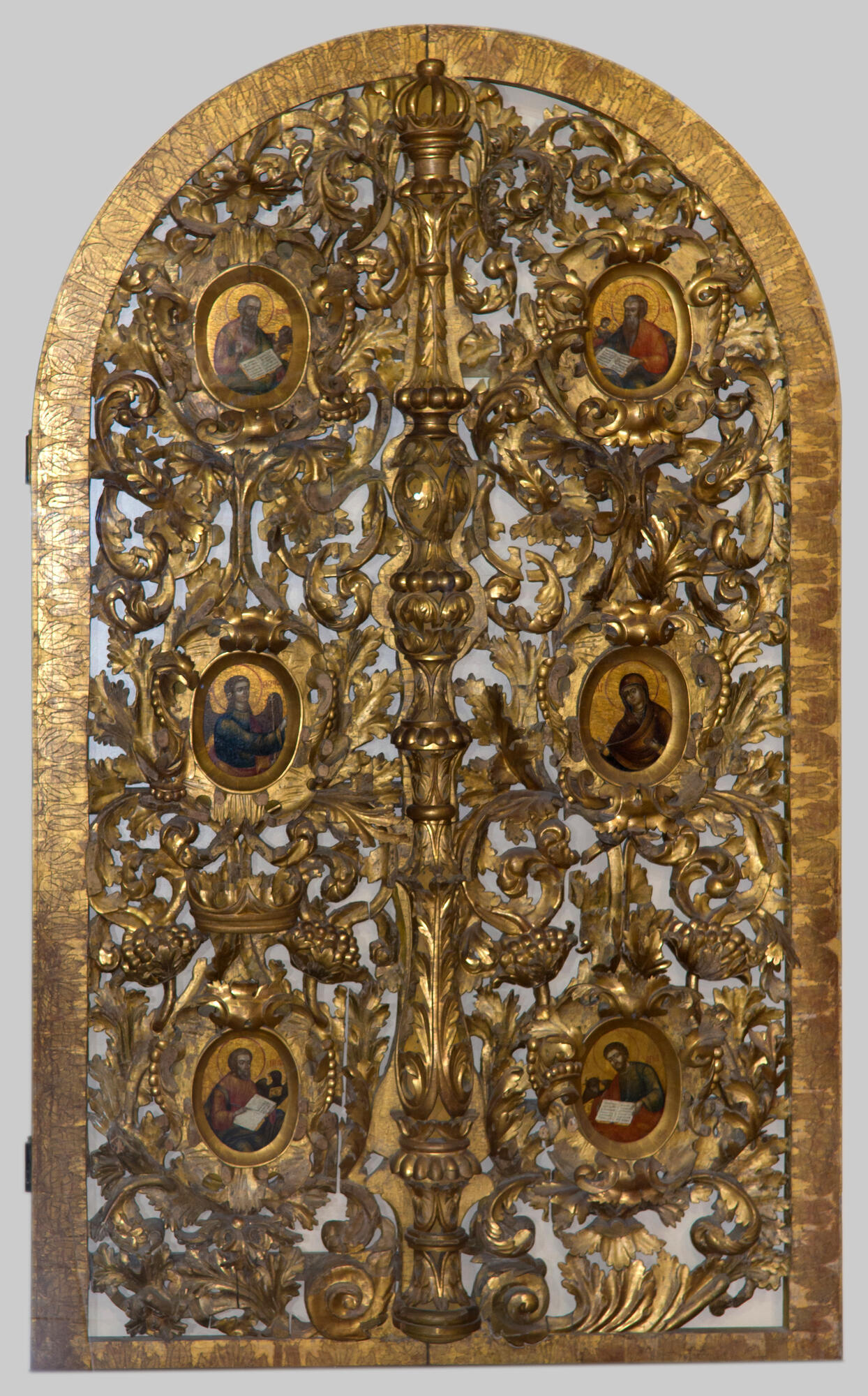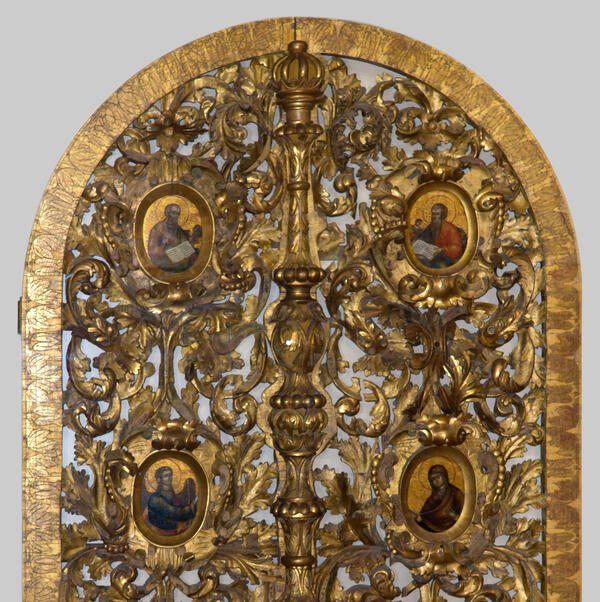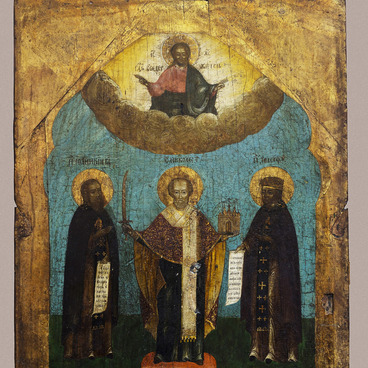In the Christian tradition, the altar space symbolizes the Kingdom of Heaven. In an Orthodox church, it is separated by an iconostasis, in the center of which there is a double door that opens the passage for the clergy - the Sanctuary Doors. The doors in the museum’s collection were decorated with the main iconostasis of the Nicholas Church in PYskor village, UsOlye District, Perm Region. They date back to the turn of the 17th-18th centuries. Icons depicting the Annunciation and the Evangelists, placed in small oval hallmarks dating back to the late 19th century.
The wooden doors are covered with a layer of primer and then thin sheets of gold leaf. Polished to a bright shine, the gold became the source of the invisible divine light. The main motif of the through-carved doors is a large floral ornament - acanthus leaves, flowers and exotic fruits. There is a clearly sculptured rampart in the form of a carved half-column, it is decorated with leaves and studded with pearls in the middle.
There are images of the Archangel Gabriel and the Virgin Mary in the carved frames in central part of the doors. Together they form the scene of the Annunciation and symbolize that after the adoption by God of the image of man and the sacrifice of Christ on the cross, the doors of the Kingdom of Heaven, closed after the fall of Adam and Eve, again became open to people.
The icons of the four evangelists are located in the upper and lower parts of the Sanctuary Doors. Their images are supplemented with iconographic symbols associated with the visions of the prophet Ezekiel and the apostle John the Theologian. It is noteworthy that these symbols are distributed according to the interpretation of the Holy Martyr Irenaeus of Lyons, adopted by the Old Believers. The lion is the symbol of John, the man is Matthew, the eagle is Mark, the calf is Luke.
St. Nicholas or NikOlskaya church was built in 1695 at the expense of the salt industrialist Grigory ShUstov. The church was a temple of the PYskor Monastery of the Transfiguration of the Saviour. Presumably, St. Nicholas Church was converted from a monastery.
In 1755 the Monastery of the Transfiguration of the Saviour was transferred to another place - to the LYsva River. The old monastery buildings were dismantled, and the St. Nicholas Church remained in the same place and served as a hospital, and later a cemetery church.
In 1929, NikOlskaya Church was closed and reopened during the war. In the mid-1950s, the temple was partially restored, but in 1962 the church was closed again. Currently, the church is not functioning, the building is in a dilapidated state. In June 2006, the temple was transferred to the Perm Epiphany Monastery, on the basis of the NikOlskaya Church it is planned to create a monastery courtyard.
The wooden doors are covered with a layer of primer and then thin sheets of gold leaf. Polished to a bright shine, the gold became the source of the invisible divine light. The main motif of the through-carved doors is a large floral ornament - acanthus leaves, flowers and exotic fruits. There is a clearly sculptured rampart in the form of a carved half-column, it is decorated with leaves and studded with pearls in the middle.
There are images of the Archangel Gabriel and the Virgin Mary in the carved frames in central part of the doors. Together they form the scene of the Annunciation and symbolize that after the adoption by God of the image of man and the sacrifice of Christ on the cross, the doors of the Kingdom of Heaven, closed after the fall of Adam and Eve, again became open to people.
The icons of the four evangelists are located in the upper and lower parts of the Sanctuary Doors. Their images are supplemented with iconographic symbols associated with the visions of the prophet Ezekiel and the apostle John the Theologian. It is noteworthy that these symbols are distributed according to the interpretation of the Holy Martyr Irenaeus of Lyons, adopted by the Old Believers. The lion is the symbol of John, the man is Matthew, the eagle is Mark, the calf is Luke.
St. Nicholas or NikOlskaya church was built in 1695 at the expense of the salt industrialist Grigory ShUstov. The church was a temple of the PYskor Monastery of the Transfiguration of the Saviour. Presumably, St. Nicholas Church was converted from a monastery.
In 1755 the Monastery of the Transfiguration of the Saviour was transferred to another place - to the LYsva River. The old monastery buildings were dismantled, and the St. Nicholas Church remained in the same place and served as a hospital, and later a cemetery church.
In 1929, NikOlskaya Church was closed and reopened during the war. In the mid-1950s, the temple was partially restored, but in 1962 the church was closed again. Currently, the church is not functioning, the building is in a dilapidated state. In June 2006, the temple was transferred to the Perm Epiphany Monastery, on the basis of the NikOlskaya Church it is planned to create a monastery courtyard.



